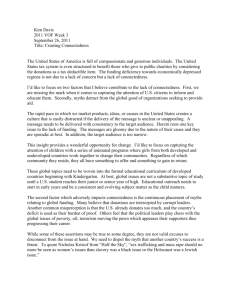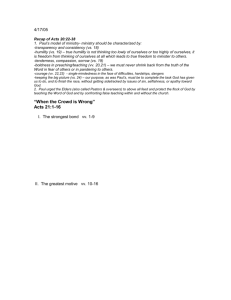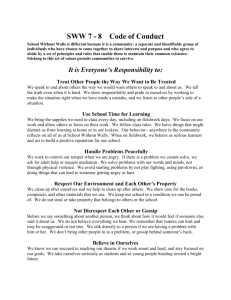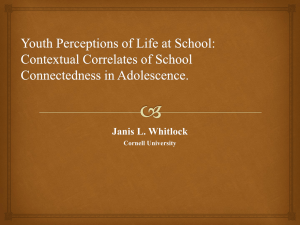ONLY CONNECT I. Theoretical Background
advertisement
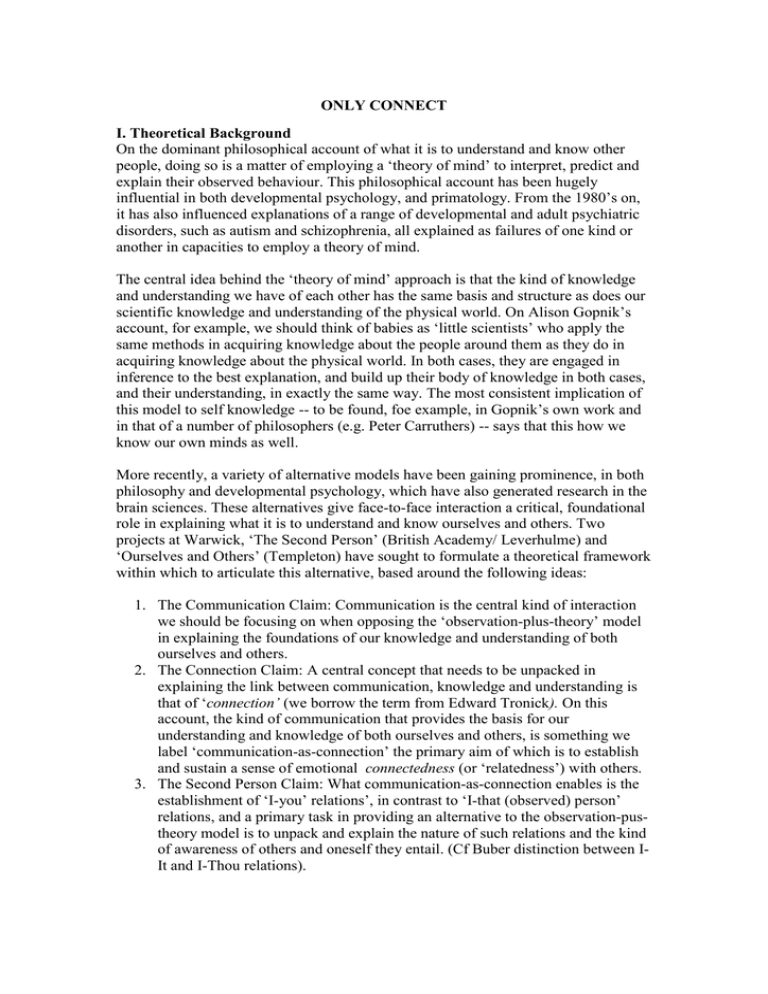
ONLY CONNECT I. Theoretical Background On the dominant philosophical account of what it is to understand and know other people, doing so is a matter of employing a ‘theory of mind’ to interpret, predict and explain their observed behaviour. This philosophical account has been hugely influential in both developmental psychology, and primatology. From the 1980’s on, it has also influenced explanations of a range of developmental and adult psychiatric disorders, such as autism and schizophrenia, all explained as failures of one kind or another in capacities to employ a theory of mind. The central idea behind the ‘theory of mind’ approach is that the kind of knowledge and understanding we have of each other has the same basis and structure as does our scientific knowledge and understanding of the physical world. On Alison Gopnik’s account, for example, we should think of babies as ‘little scientists’ who apply the same methods in acquiring knowledge about the people around them as they do in acquiring knowledge about the physical world. In both cases, they are engaged in inference to the best explanation, and build up their body of knowledge in both cases, and their understanding, in exactly the same way. The most consistent implication of this model to self knowledge -- to be found, foe example, in Gopnik’s own work and in that of a number of philosophers (e.g. Peter Carruthers) -- says that this how we know our own minds as well. More recently, a variety of alternative models have been gaining prominence, in both philosophy and developmental psychology, which have also generated research in the brain sciences. These alternatives give face-to-face interaction a critical, foundational role in explaining what it is to understand and know ourselves and others. Two projects at Warwick, ‘The Second Person’ (British Academy/ Leverhulme) and ‘Ourselves and Others’ (Templeton) have sought to formulate a theoretical framework within which to articulate this alternative, based around the following ideas: 1. The Communication Claim: Communication is the central kind of interaction we should be focusing on when opposing the ‘observation-plus-theory’ model in explaining the foundations of our knowledge and understanding of both ourselves and others. 2. The Connection Claim: A central concept that needs to be unpacked in explaining the link between communication, knowledge and understanding is that of ‘connection’ (we borrow the term from Edward Tronick). On this account, the kind of communication that provides the basis for our understanding and knowledge of both ourselves and others, is something we label ‘communication-as-connection’ the primary aim of which is to establish and sustain a sense of emotional connectedness (or ‘relatedness’) with others. 3. The Second Person Claim: What communication-as-connection enables is the establishment of ‘I-you’ relations’, in contrast to ‘I-that (observed) person’ relations, and a primary task in providing an alternative to the observation-pustheory model is to unpack and explain the nature of such relations and the kind of awareness of others and oneself they entail. (Cf Buber distinction between IIt and I-Thou relations). II. The Only Connect Project The Only Connect Project is funded by the Warwick Impact Fund. The underlying rationale behind the project is this. The idea that our knowledge and understanding of ourselves and others is founded in emotionally-laden communicative relations has long been evident, and indeed central, both in developmental psychopathology and a rich array of clinical theories and practices, where the aim is to explain, diagnose and intervene in a variety of disorders. One aim of the project, put maximally generally, is to draw on insights provided by both theory and practice in these areas, and in developmental psychology, to gain a better understanding of (a) how we should unpack the notion of ‘communication as connection’ and explain its role in grounding our understanding and knowledge of ourselves and others; and (b) how we should explain what exactly is wrong, and why, with the observation-plus-theory model. A second, no less important aim, is this. On some level and in some sense, much of the suffering and psychological damage sustained by individuals can be explained by appeal to some kind of breakdown in connectedness and the sense of isolation it entails.. The hope is that project will also provide a preliminary forum for discussing ways of implementing these insights in relevant institutions and frameworks. III. The Workshop The exploratory workshop brings together people who work in a variety of disciplines. Each has worked on explanations and/or diagnoses and/or interventions, with infants, adolescents, and adults, at the core of which work we find numerous insights into the questions we seek to explore and make progress with. Such questions include, but are by no means restricted to the following. 1. The mechanisms that enable the creation and sustaining of various forms of non-verbal communication, in various situations and cases, and in various sensory modalities (sight, touch, hearing etc) 2. The role these different mechanisms have in communicating, creating and sustaining a variety of emotions. 3. The relations between verbal and non-verbal communication in a variety of cases. 4. Differences and similarities between explanations of difficulties in establishing and sustaining connectedness in various cases (e.g. autism. dementia, a variety of problems and can be attributed to failures in securing ‘attachment’, communication with deaf-blind children and adults, and so forth). 5. The relations between accounts of what is required for establishing connectedness at a time and what is required for establishing a lasting, longterm sense of connectedness with others. 6. The nature of the communicative relations between therapist/clinician and patient. 7. The underpinnings and nature of ‘you-awareness’, and its relation to selfawareness/knowledge. 8. Ideas for ways of translating all of these insights into practice in various institutions.
